How to Use UTM Tracking to Optimize Survey Responses
UTM tracking is a simple but powerful method to optimize your surveys and understand exactly where your responses are coming from. Are your best insights arriving from email, paid ads, or social media? Without tracking these sources, your survey data may be incomplete and misleading.
Fortunately, UTM tracking can connect every survey response to a specific marketing campaign or channel. With this knowledge, marketers can measure campaign effectiveness, improve response quality, and make smarter decisions.
Let’s explore how UTM tracking works, why it matters in surveys, and how you can use it to improve your feedback strategy.
What is UTM Tracking?

UTM tracking stands for Urchin Tracking Module, a system of parameters added to URLs to capture marketing data. This data shows where traffic is coming from and how users behave after clicking a link. UTM codes are essential in digital marketing, especially when managing multiple campaigns or traffic sources.
By appending UTM parameters to a survey link, you can identify where the person clicked from. This may be a social media post, a newsletter, a paid ad, or a blog article.
What does UTM stand for?
UTM stands for Urchin Tracking Module. Urchin Software was a web analytics company acquired by Google in the early 2000s. Their tracking method became the foundation of Google Analytics.
What is a UTM parameter?
A UTM parameter is a tag added to a URL to record key information about the source of the click. There are five standard UTM parameters:
- utm_source – Identifies the platform (e.g., Facebook, Email, LinkedIn)
- utm_medium – Defines the type of channel (e.g., social, newsletter, cpc)
- utm_campaign – Names the specific campaign (e.g., summer_promo)
- utm_term – Used to track paid search terms
- utm_content – Differentiates links that point to the same URL
These tags are added to URLs, which then appear like this:
https://yoursurveytool.com/feedback?utm_source=facebook&utm_medium=social&utm_campaign=feature_launch
When someone clicks this link, the UTM parameters get passed into tools like Google Analytics. You can then analyze how each channel contributes to traffic and conversions.
Why UTM tracking matters
Marketers use UTM tracking to understand which campaigns are most effective. Without it, measuring the performance of content, ads, or email campaigns becomes difficult. UTM tracking also supports clear attribution, allowing you to know which channel drives the best results.
When applied to surveys, UTMs add even more value. You’ll be able to see which channel leads to better survey completion rates and higher-quality responses.
Why Use UTM Tracking in Surveys?
Surveys are a key part of feedback and decision-making. However, unless you track where responses come from, you risk making choices based on incomplete data.
Using UTM tracking for survey distribution solves this issue. Here’s how:
Connect responses to specific campaigns
With UTMs, you can track responses from different marketing campaigns. This way, you’ll know whether feedback is coming from a paid campaign, an email sequence, or organic website traffic.
For example, if a survey about a new product gets more positive responses from email users, you’ll know that your email campaign is targeting the right segment.
Compare audience engagement by channel
UTM tracking helps identify the quality of responses from different sources. For instance, visitors from LinkedIn might complete your survey more often, while those from paid ads might drop off midway.
These insights allow you to perform survey analysis at a deeper level and tailor your outreach to more engaged users.
Measure campaign ROI
Marketing campaigns are expensive. If your team is investing in paid traffic, you want to know if those users are also participating in feedback activities.
UTM data can show how many respondents came from each campaign and how engaged they were. This leads to better marketing campaign tracking and smarter spending decisions.
Support better segmentation
When you connect UTMs with survey analytics, you can segment results based on audience behavior. This supports better market segmentation strategies.
For example, product managers might notice that users from organic search report more satisfaction than those from ads. With this information, the team can explore why this difference exists and adjust the product or messaging accordingly.
How UTM Survey Targeting Works
Let’s look at how to use UTM tracking in practice. The goal is to embed UTMs in every survey link you share and then use that data to analyze your survey results more effectively.
Step 1: Add UTM parameters to your links
You can use a UTM builder to create custom URLs. These tools make it easy to fill in each parameter and generate a unique link.
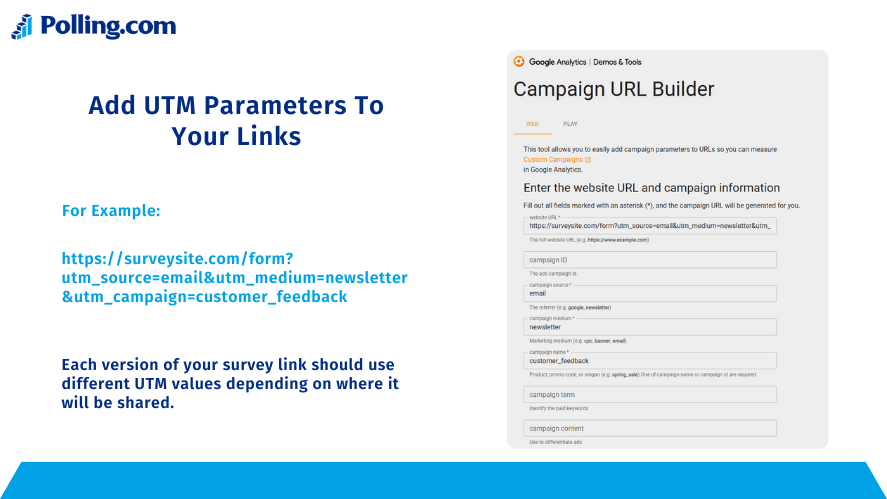
Step 2: Distribute the survey on multiple channels
Share your survey link across all active platforms:
- Email campaigns
- Facebook or LinkedIn ads
- Website pop-ups or blog articles
- Social media posts
- Influencer outreach
Each link should include unique utm_source and utm_medium values to track the origin.
Step 3: Segment data by UTM tags
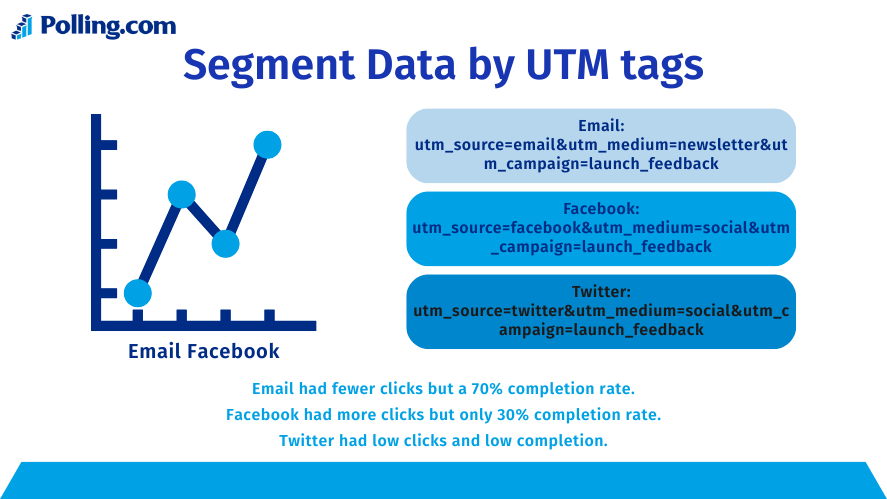
Once responses come in, sort them based on their UTM parameters. Many platforms offer built-in reporting, or you can export your survey responses to a spreadsheet.
Some platforms also allow coding survey responses with UTM fields, making analysis even easier.
Real-world example
Imagine you’re running a satisfaction survey after a product launch. You share the survey via:
- A product update email
- A Facebook ad
- A pinned post on Twitter
Here’s how your UTM-tagged links might look:
- Email: utm_source=email&utm_medium=newsletter&utm_campaign=launch_feedback
- Facebook: utm_source=facebook&utm_medium=social&utm_campaign=launch_feedback
- Twitter: utm_source=twitter&utm_medium=social&utm_campaign=launch_feedback
After a week, you find:
- Email had fewer clicks but a 70% completion rate.
- Facebook had more clicks but only a 30% completion rate.
- Twitter had low clicks and low completion.
This is exactly the kind of insight advanced survey analytics can deliver when UTMs are used correctly.
Benefits of UTM Survey Targeting
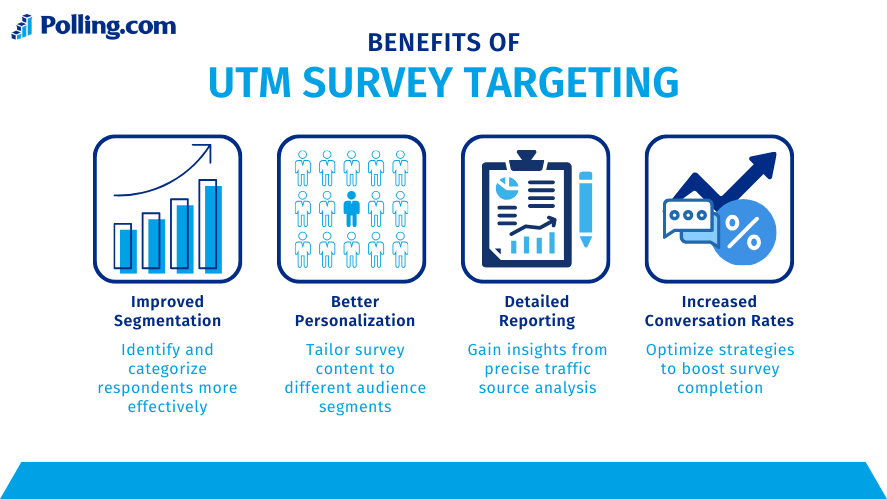
There are several advantages to using UTM tracking in your survey strategy. These benefits apply whether you’re running a simple feedback form or a complex multi-channel campaign.
1. Smarter Audience Segmentation
When you know where each response is coming from, you can segment your audience by behavior and source. For example, responses from paid ads may come from new users, while email responses may reflect your loyal customer base.
This segmentation helps guide product improvements, support messaging, and more.
2. Better Conversion Analysis
Clicks are one thing. Completed surveys are another.
UTM tracking allows you to compare click-through rates with completion rates. You’ll see which campaigns generate real engagement, not just traffic.
3. Informed Marketing Decisions
By knowing which channel delivers the most valuable responses, you can shift budget toward the most effective platforms. If email users offer better feedback, you might invest more in newsletter development.
This helps marketers make decisions based on real data, not guesses.
4. Campaign Attribution and ROI
Want to prove that your latest ad campaign improved product understanding or customer satisfaction? Use UTMs to track which users responded to a survey, and what they said.
This provides a clear link between campaigns and business results—something every marketing team needs.
How to Set Up UTM Tracking for Surveys
To set up UTM tracking properly, follow these steps.
Define your goals and distribution channels
Start by outlining what you want to learn from the survey. Is it user satisfaction? Feature testing? Pricing feedback?
Then decide where the survey will be shared:
- Social media
- Paid ads
- Blog content
- Customer portals
Use a link creator or UTM builder
You can create UTM URLs manually, but it’s easier with a UTM builder like Google’s Campaign URL Builder. This tool helps you avoid errors and stay consistent.
Make sure to include:
- utm_source (e.g., newsletter, facebook, linkedin)
- utm_medium (e.g., email, social, cpc)
- utm_campaign (e.g., user_feedback_sep)
For clarity, keep all UTM values lowercase and use underscores for spaces.
Best Practices for UTM Survey Targeting
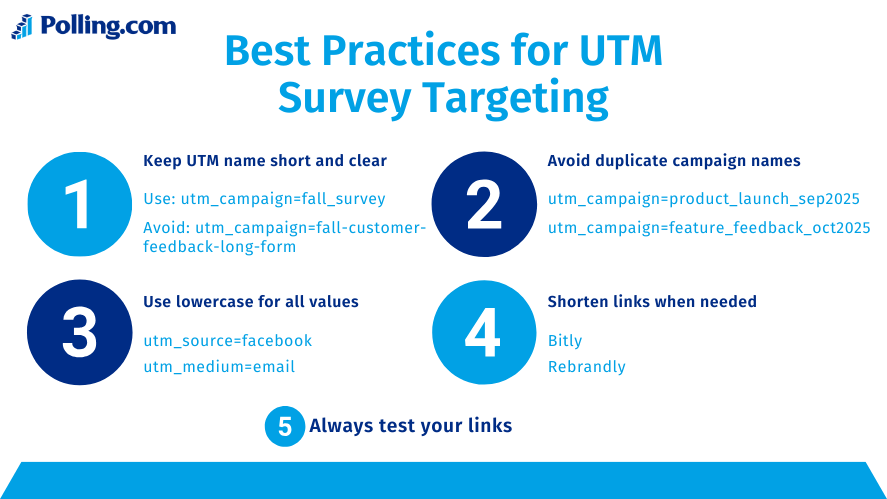
Now that you know how UTM tracking works, let’s make sure you are using it the right way. Following these best practices will help you avoid errors and get cleaner data.
1. Keep UTM names short and clear
When naming your UTM parameters, use simple and readable words. This makes it easier to manage links later.
For example:
- Use: utm_campaign=fall_survey
- Avoid: utm_campaign=fall-customer-feedback-long-form
Shorter names reduce confusion and look better when links are shared.
2. Use lowercase for all values
Consistency matters in UTM tracking. Most analytics platforms treat uppercase and lowercase differently. That means Facebook and facebook would be counted as separate sources.
To avoid this, use lowercase only:
- utm_source=facebook
- utm_medium=email
3. Avoid duplicate campaign names
Using the same campaign name across different promotions may lead to inaccurate tracking. Always update your campaign name with the right context or date.
For example:
- utm_campaign=product_launch_sep2025
- utm_campaign=feature_feedback_oct2025
This way, you can track campaigns separately and compare their performance more easily.
4. Shorten links when needed
Long URLs with UTM parameters can look messy. Use link shorteners like:
- Bitly
- Rebrandly
This not only looks cleaner but also improves user experience, especially on mobile devices.
5. Always test your links
Before sending out your survey, test each UTM-tagged link. Open it in a browser and confirm it goes to the correct survey form. Then, check if the analytics system or survey platform is capturing the UTM parameters.
Testing avoids issues where links break or fail to collect data.
Common Mistakes to Avoid
Even though UTM tracking is simple, mistakes can still happen. These errors can lead to lost data or misleading reports.
1. Forgetting to use UTMs on every channel
You must tag every survey link you share. Leaving some links without UTM parameters makes it impossible to trace their source. This results in “direct” or “unknown” traffic in your reports.
2. Overloading links with unnecessary parameters
Only use UTM parameters that add value to your analysis. Avoid tagging every link with all five UTM parameters unless they are truly needed. Simpler links are easier to manage and less likely to confuse users.
Better:
utm_source=email&utm_medium=newsletter&utm_campaign=fall_feedback
Avoid:
utm_source=email&utm_medium=newsletter&utm_campaign=fall_feedback&utm_term=customer&utm_content=header_button&utm_topic=nonexistent
3. Not aligning with your marketing reports
Your survey UTMs should match your general marketing UTM structure. That way, all data fits together in your reports. When UTMs are inconsistent, it becomes harder to connect survey data to campaign performance.
4. Only tracking clicks, not completions
Some marketers stop at tracking survey clicks. However, a clicked link doesn’t always mean a completed survey. Make sure your survey platform supports tracking completions tied to UTM parameters. This is how you unlock real survey analysis.
Case Study: Improving Survey ROI with UTM Tracking
Let’s walk through a real-world example of how UTMs helped a business improve its survey return on investment.
Business: GrowthMind Tools (Fictional B2B SaaS Company)
Survey Goal: Gather feedback about a new dashboard feature Audience: Active users Channels Used:
- Email campaign
- LinkedIn ads
- In-app banner
- Blog post
UTM Setup:
Each channel used a unique UTM-tagged survey link:
- Email:
utm_source=email&utm_medium=newsletter&utm_campaign=dashboard_feedback
- LinkedIn:
utm_source=linkedin&utm_medium=social&utm_campaign=dashboard_feedback
- In-app:
utm_source=app&utm_medium=internal&utm_campaign=dashboard_feedback
- Blog post:
utm_source=blog&utm_medium=organic&utm_campaign=dashboard_feedback
Results after 2 weeks:
ChannelClicksCompletionsCompletion RateEmail60051085%LinkedIn1,20036030%In-app90072080%Blog45015033%
Key Takeaways:
- Email had fewer clicks but the highest completion rate.
- In-app survey links also performed well, showing that engaged users respond more when already using the product.
- LinkedIn drove traffic but low-quality responses.
- Blog traffic gave decent returns, but not at scale.
Decision Made:
The marketing team decided to reduce paid spend on LinkedIn and increase focus on in-app surveys and email. This change helped them cut costs while improving response quality.
Lesson Learned:
Without UTM tracking, the team would not have seen how each channel performed. By comparing both click volume and completions, they made better marketing and product decisions.
The Future of UTM Tracking in Surveys
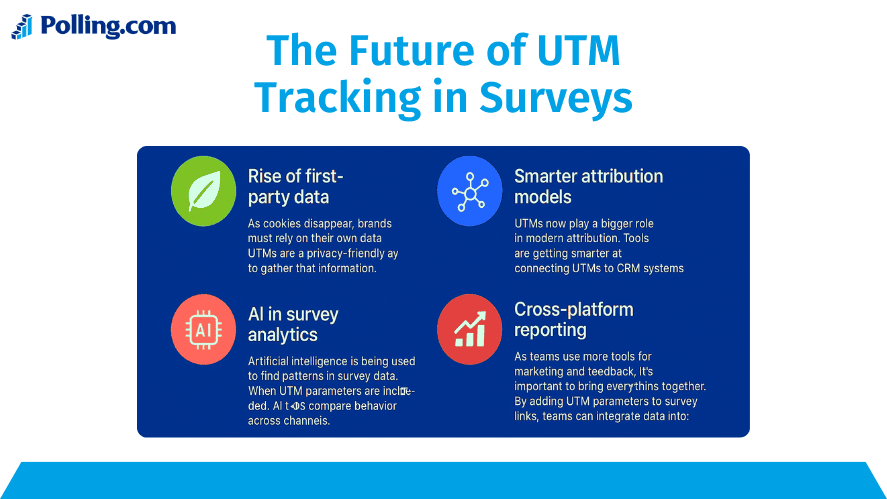
The digital landscape is changing fast. Third-party cookies are being phased out, and privacy laws are getting stricter. In this environment, UTM tracking is becoming more valuable than ever.
1. Rise of first-party data
As cookies disappear, brands must rely on their own data. UTMs are a privacy-friendly way to gather that information. They let you connect marketing activity with user actions without tracking personal details.
2. Smarter attribution models
UTMs now play a bigger role in modern attribution. Tools are getting smarter at connecting UTMs to CRM systems, helping teams see the full customer journey from first click to survey response to product purchase.
3. AI in survey analytics
Artificial intelligence is being used to find patterns in survey data. When UTM parameters are included, AI tools can compare behavior across channels. This opens the door to predictive insights, especially when using advanced survey analytics tools.
4. Cross-platform reporting
As teams use more tools for marketing and feedback, it’s important to bring everything together. By adding UTM parameters to survey links, teams can integrate data into:
- Google Analytics
- CRM systems
- Email marketing platforms
- Business dashboards
This creates a unified view of performance across the board.
Exploring Better Survey Tools
Running surveys is not only about collecting responses but also about ensuring the process is smooth, accessible, and efficient. Many organizations struggle with managing multiple channels, tracking participation, and analyzing results in one place. This makes survey platforms that provide flexible forms and reliable analytics very valuable.
For example, Polling.com is one platform often used by teams that need to design surveys quickly, distribute them across different channels, and view results in a clear dashboard. It supports various types of survey methods, which makes it useful for researchers, marketers, and product managers.
If you are looking for ways to simplify your survey workflow, exploring solutions like Polling.com can give you a more structured process and more reliable outcomes.
Frequently Asked Questions (FAQs)
UTM tracking adds tags to links so you can see where clicks or survey responses come from, like email, ads, or social media.
It shows which channels drive the most responses, making it easier to analyze survey results and improve campaign ROI.
UTM parameters are codes like utm_source, utm_medium, and utm_campaign that track the source and purpose of a link.
You can use a UTM builder or link creator, such as Google Campaign URL Builder, to generate tagged URLs quickly.
Yes. If your survey platform records UTMs with responses, you can track not just clicks but also completions.
Avoid inconsistent naming, forgetting to add UTMs to all links, or tracking only clicks instead of completions.
Yes. UTMs do not rely on cookies or personal data, which makes them safe under modern privacy laws.
Making the Most of UTM Survey Targeting
UTM tracking helps marketers and researchers understand where their survey results are coming from and how different audiences behave. Instead of guessing which campaigns bring in the best feedback, UTMs provide a direct answer.
By using UTMs in your survey strategy, you can:
- Connect responses to campaigns
- Improve market segmentation
- Increase survey completions
- Optimize your survey process
- Support clear and accurate marketing ROI
If you are serious about data-driven decision-making, start using UTM tracking in your next survey. It is a small change with a big impact.
